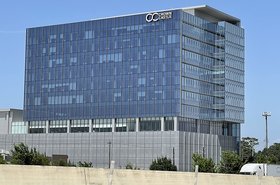The chaos and confusion caused by escalating tariffs are hard to predict.
For example, this piece was originally written yesterday, was re-written during the day, and then once again today. Business plans are similarly being rewritten, as markets cling to signs of good news - such as the 90 day reciprocal reprieve for most countries - and eye escalating tariffs against China with caution.
I would love to be able to tell you what the coming days, weeks, and months will mean for the data center sector, but the reality is that no one knows how things are going to end. The US is locked in a game of brinkmanship, but with no clear advantageous outcome.
The market is in freefall. Prices on components and commodities are set to spiral. Money is already harder to come by.
How bad things are set to be will depend in part on how real Trump's tariffs are, and how aggressively the rest of the world responds. We do know one thing, however: A lengthy trade war between the US and the entire world will, naturally, cause costs to go up and markets to go down.
While the reprieve has helped ease some of the panic, 10 percent tariffs are remaining, Chinese tariffs are getting worse, and it's unclear what will happen after 90 days (or even if the US will stick to that).
Building a US manufacturing base will take years, if it will even happen. Those factories will produce products at a higher price, and will still have to rely on supplies and equipment from overseas - themselves taxed, adding further cost increases.
Semiconductors, IT equipment, and other data center supplies are deeply complex products that cannot shift on a whim. Globalized supply chains are inherent in their creation, and no tariff can reverse this reality.
For data centers, this sudden disruption comes at a critical time. The sector is in the midst of a record run, as money flows into ever larger AI projects. Those projects will become more expensive, with the full cost increase hard to predict.
Steel, servers, and other equipment could jump by some 30 percent or more, and delays could be expected as some look to wait out what they hope is a temporary negotiating tactic.
A wider market slowdown and looming recession will lead to non-data center businesses going under or slashing spending, impacting their IT contracts. Cost increases on services provided by data centers will be passed on, limiting how much companies will buy.
Already, shares in tech giants, server makers, and channel suppliers have plummeted. Current tariffs don't include semiconductors, but President Trump has threatened that they will come soon.
The uncertainty makes things all the worse, as project managers have no way of working out how much a multi-year project will actually cost. Nobody knows anything, everyone is trying to build on quicksand.
Even without tariff surprises, ballooning valuations and wild promises of superhuman AI caused many to fear it was unsustainable and in need of correction. A slew of companies with little experience operating at scale, raising debt on high interest tied to rapidly-depreciating semiconductors made the situation all the more febrile.
To justify increasingly large capex investments, data centers have to be able to project confidence in the future - not just for now, or next year, but for the 15 or so years a facility may be in operation.
For the generative AI companies, core to this pitch is that these 'AI factories' are the beginning of a profound revolution.
OpenAI have been the masters of selling this story, propped up in part by truly incredible AI advances, but primarily buoyed by the promise of much greater achievements over the next five years.
As they look to raise $500 billion, the company has to convince people that it is on the cusp of something truly profound: A new form of intelligence far greater than our own. What do higher tariffs matter if you can get in on the ground floor of owning a god?
But, of course, as much as Sam Altman or others would like you to believe that this is inevitable, it's not. Greater forms of generative AI are guaranteed, but we do not know if there are fundamental limits to this approach - we do not even know how to accurately measure our own intelligence, or what replicating or superseding it really means.
As markets get tougher, expect the messaging around the coming AI to get louder.
Ultimately, they may prove to be right - but just remember that they do not actually know if what they are promising is possible, they just hope that by saying it enough, they'll raise enough to maybe get there. As raising gets harder, they will have to say it all the more.
Data center supplier CoreWeave has also had to manage this delicate negotiation between the realities of today and the promise of tomorrow. After loading up on billions of expensive debt, it sought an IPO earlier this month, pitching a business that only makes sense if there are set to be several more waves of growth.
Should things stall, those 12.5 percent interest payments will start to catch up.
Impacted by reports of a Microsoft pullback and concerns over its balance sheet, it pared down its stock market expectations, looking to raise $1.5bn instead of $2.7bn. Supplier Nvidia stepped in to guarantee a $250m order, with the GPU company itself desperate to prop up its customers.
On IPO day, things were looking good as investors got behind its vision. Shares quickly soared over the following two days.
Then came the tariffs. Higher than expected, poorly communicated to the market, and based on an illogical formula, investors were spooked. Most of CoreWeave's gains were quickly wiped out, along with trillions from the wider market.
As we suffer another week of trade wars, there are a few scenarios that could play out.
Should the tariffs be short-lived, there will still be disruptions. Some products delivered during this time will cost more, and that will be passed down the supply chain. Other products will not be ordered, as companies wait for this to pass, causing delays.
Should they drag on, expect cost increases all along the data center supply chain - both in the US and abroad.
Expect lots of announcements about US factories being built, potentially in return for near-term tariff reprieves. Many of these factories will be slow-walked and fail to materialize - similar to the giant Foxconn factory in Wisconsin that never came to be (the land ultimately was sold to Microsoft for a data center).
Investors could bifurcate. In my conversations with the monied few, I came across true believers and ride-alongs. The latter does not actually believe that AI advances will bring about a new superhuman, but were happy to invest in it as long as the line kept going up.
The true believers, on the other hand, will continue to invest as long as they can, tariffs and market conditions be damned. However, with costs increasing and markets trembling, they'll have a harder time raising money, and that money will be able to buy less.
Other second-order impacts could happen. In the wake of the Snowden revelations, where it was revealed that the US was spying on most of the world using US tech backdoors, those same firms struggled to make headway in China. Many were forced to sell off to local firms, or leave entirely.
In Europe, a slew of cloud companies set up in the hopes of building alternatives that were not beholden to US surveillance demands. While they carved out a niche, US firms have still dominated.
These aggressive tariffs, against allies and long-term trading partners, will similarly have a damaging effect on the global perception of US data center firms.
That giant data center you want to build in Thailand for a hyperscaler? It's now a pawn in a negotiation where the country is trying to survive 10 percent tariffs today, and looming 36 percent tariffs. TikTok's $8.8bn data center investment in the country, meanwhile, will face less pushback.
Some of this distrust will persevere even if the tariffs are fully reversed. The best case scenario is that several countries announce free trade deals with the US and the White House spins this mistake as the plan all along. But nations that were bullied and coerced into a chaotic negotiation with no clear demands won't soon forget.
Regulation on US cloud providers overseas will get stronger, and demands for alternatives will grow. The good news for the hyperscalers is that they're so enmeshed with the fabric of most nations that such efforts will likely struggle - just as they did post-Snowden.
Many nations, particularly in APAC, will instead further open the doors to Chinese cloud providers - figuring diversifying their infrastructure between the two superpowers is at least safer.
A much worse second-order outcome of the US deciding to turn against the world is that it takes us a step closer to previously unlikely scenarios. An invasion of Greenland by the US, or the invasion of Taiwan by China remain hard to fathom, but are both genuine possibilities with far-reaching impacts on the sector and the world.
As we shift from the information age into the age of uncertainty, panic and doubt risk hampering data centers' fantastic growth.
However, the industry will persevere. Even in market pullbacks, users and companies will need digital services, and some will look to AI for quick wins. Growth is still possible: Data centers are not going anywhere. They will just have to be more cautious about how they proceed.





